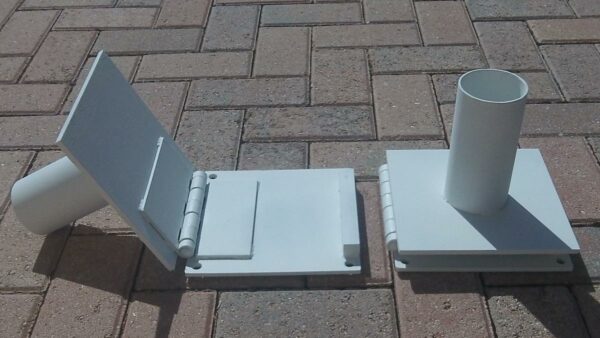Introduction
Most of us have installed temporary antenna masts and have looked for a way to raise, lower and guy the masts while working alone. This was the case when I wanted to raise three masts for temporary antenna testing. When I couldn’t find any tilt-over bases that were sturdy, I decided to design and build some of my own from readily available materials.
I wanted mast bases that were rugged and heavy, not thin and flimsy. I discovered that mild steel [1] with its high carbon content is easy to weld, so I settled on that material. I also found a source for mild steel hinges [2]. They were perfect matches for mild steel plate. (In case you prefer aluminum, heliarc welding has become routine. It all depends upon what the welder quotes for a price and how heavy you want the bases to be.)
A sketch of what was built appears in Figure 1. All of the dimensions are based upon available materials. The only cutting required was to fabricate a steel shim [3]. When the tilt-over base is in its upright position, this shim, which is the same thickness as the hinges, maintains the spacing between the steel plates.
Figure 1. Design Sketch. The small holes in the left base plate accommodate 3/8” spikes (see text). The steel tube is welded to the rear side of the right top plate (see text).
A local welder assembled three tilt-over base mounts from supplied 8″ x 8″ x 1/4″ mild steel plate, 3″ OD 11 gauge steel tube, 6″ x 6″ steel hinges, and 3/4″ x 3/4″ x 6″ steel bar stock. The steel plate, hinges and bar stock were ordered from Amazon, while the tubing [4] was ordered from Coremark. The ID of the base tube is 2.75″ (70mm), 11ga. This is a loose fit for the cap at the bottom of most fiberglass masts. I used felt blankets [5] as shims for a tighter fit and to protect the masts. The base mounts are anchored to the ground with 3/8″ x 12″ galvanized spikes [6]. Four ½” holes drilled in the bottom plate for this purpose are visible. The spikes prevent the bases from sliding while the masts are being raised and lowered.
Once welded, the welding flux should be removed. Since high carbon steel will rust, the welded assemblies were cleaned and prepped with phosphoric acid [7] and steel wool before priming with spray metal primer [8]. The primed bases were spray-painted [9]. The finished product is shown in Figure 2.
Figure 2. Tilt-Over Bases. These tilt-over mast bases are sturdy and stable when anchored to the ground with 3/8″ x 12” galvanized spikes. The tilt-over feature makes it easy to raise and lower portable telescoping and non-telescoping masts while working alone.
A typical installation is shown in Figure 3. The 33’ (10m) masts shown were guyed at two levels with guy rings. Four Dacron paracord guy ropes were used on each guy ring. Fluorescent orange paracords were used for enhanced visibility. Temporary ground anchoring is accomplished with polycarbonate Orange Screws [10] as shown in Figure 4. Taut-line hitches are used to tighten the guying ropes – a useful knot to remember.
The mast is raised with two lower guy ropes in place. The ropes are adjusted to hold the mast a few degrees past vertical until the final two lower guy ropes are placed. Finally, the upper four guy ropes are placed.
Figure 3. Typical Installation. Guying is performed at two levels. The mast is raised while working alone with two lower guy ropes in place. The ropes are adjusted to hold the mast a few degrees past vertical until the final two lower guy ropes are placed. Finally, the upper four guy ropes are set. A post level, visible on the mast, is used to true it up. Photo courtesy of N4UM.
Figure 4. Guy view. The masts are guyed at two levels. Eight Dacron paracord ropes are used. The paracords are fastened to the guy rings with snap hooks. Tensioning is adjusted with taut-line hitches. Photo courtesy of N4UM.
Figure 5. Orange Screw Ground Anchors. The guy ropes are adjusted with taut-line hitches. During antenna range testing, the Orange Screws were set in sandy soil. Three masts remained standing during two weeks of rain and stiff winds.
Figure 6. Antenna Range with 3 Tilt-Over Bases in Use. An antenna range was constructed with three fiberglass masts and tilt-over bases. The dimensions of the range are as pictured. This 140’ range was left unattended during 2 weeks of Florida spring wind and rain. Note that paracord back-guys were employed at the very tops of the north and south masts to relieve the lateral loading due to the weight of the wire. Without back-guying, the top sections of the telescoping masts are apt to snap off.
References*
[1]https://www.amazon.com/s?k=8+x+8+x+1%2F4+steel+plate&crid=188CJTXB7VM3W&sprefix=8+x+8+x+1%2F4+steel+plate%2Caps%2C585&ref=nb_sb_noss_2
[2]https://www.amazon.com/Hinge-Weld-Heavy-Metal-Doors/dp/B0821HQQSJ/ref=sr_1_5?crid=3UEBPDTTXJFF8&keywords=6%22%2Bsteel%2Bhinges&qid=1656544819&sprefix=6%2Bsteel%2Bi%2Caps%2C107&sr=8-5&th=1
[3]https://www.amazon.com/1018-Drawn-Steel-Square-Stock/dp/B09GY7MQ2V/ref=sr_1_3?crid=3DB0BOW75U320&keywords=3%2F4+steel+bar+stock&qid=1656544926&sprefix=3%2F4+steel+bar%2Caps%2C192&sr=8-3
[4]https://www.coremarkmetals.com/electric-welded-erw-round-steel-tube
[5]https://www.homedepot.com/p/Everbilt-2-in-x-4-in-Heavy-Duty-Self-Adhesive-Beige-Felt-Blanket-3-Pack-804614/306229475?
[6]https://www.lowes.com/pd/Grip-Rite-12-in-x-3-8-in-Spike/3610436
[7]https://www.homedepot.com/p/Klean-Strip-1-Gal-Concrete-Etch-Metal-Prep-and-Rust-Inhibitor-GKPA30220/100406369
[8]https://www.homedepot.com/p/Rust-Oleum-Stops-Rust-12-oz-Flat-White-Clean-Metal-Primer-Spray-7780830/100143442
[9]https://www.homedepot.com/p/Rust-Oleum-Stops-Rust-12-oz-Protective-Enamel-Semi-Gloss-White-Spray-Paint-7797830/205585926
[10]https://www.sportsmans.com/camping-gear-supplies/tents-shelters/tent-accessories/orange-screw-small-ground-anchor-4-pack/p/1531885?channel=shopping&gclid=Cj0KCQjw8O-VBhCpARIsACMvVLMO-RmVGrVvtXURmIiQcQRsAo_r91rbskWRWtAzqqAUniop6Wnm5QYaAutREALw_wcB
[11]https://www.amazon.com/Orange-Screw-Ultimate-Ground-Anchor/dp/B01D3UIA5A/ref=asc_df_B01D3UIA5A/?tag=hyprod-20&linkCode=df0&hvadid=167119746601&hvpos=&hvnetw=g&hvrand=17637355299886752168&hvpone=&hvptwo=&hvqmt=&hvdev=c&hvdvcmdl=&hvlocint=&hvlocphy=9002271&hvtargid=pla-307839372670&psc=1
*The references cite readily available sources of supply. You may be able to find lower prices for materials or substitutions elsewhere.




No comments:
Post a Comment